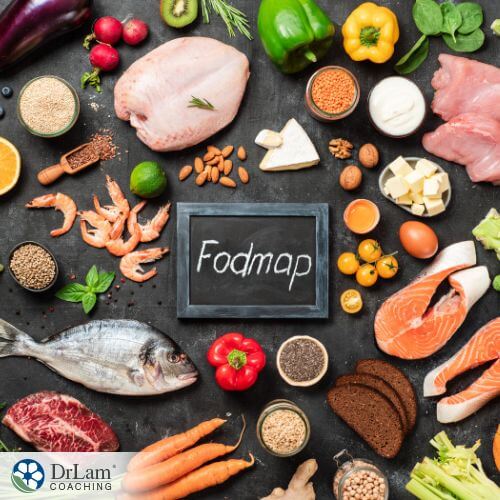 In recent years, the low FODMAP diet has been increasingly accepted as a way of managing irritable bowel syndrome (IBS). In addition, some consultants also approve of its use for small intestinal bacterial overgrowth (SIBO). This novel acceptance is one reason you have heard about the low FODMAP diet more in the past few years.
In recent years, the low FODMAP diet has been increasingly accepted as a way of managing irritable bowel syndrome (IBS). In addition, some consultants also approve of its use for small intestinal bacterial overgrowth (SIBO). This novel acceptance is one reason you have heard about the low FODMAP diet more in the past few years.
A low FODMAP diet is low in fermentable carbs to help ease the discomfort from IBS and SIBO. These two common digestive disorders feature symptoms like stomach cramps, bloating, and other intestinal distresses.
There is much to know about low FODMAP diets, but little is available in academic works. So, what is the low FODMAP diet?
FODMAP is an acronym for “fermentable oligosaccharides, disaccharides, monosaccharides, and polyols.” They are short-chain carbohydrates that do not digest easily in the small intestine. Therefore, people with sensitive stomachs or digestive issues like IBS and SIBO may experience discomfort after consuming them.
Common symptoms you may experience after eating high FODMAP foods include constipation, stomach cramps, bloating, diarrhea, gas, and flatulence. These reactions are a result of the nondigestible characteristics of these foods. A low FODMAP diet may reduce these symptoms.
On a low FODMAP diet, you reduce your intake of foods high in FODMAP. The amount and type of FODMAPs in different foods vary.
Unfortunately, the FODMAP diet does not always work for everyone with IBS/SIBO. However, many report a decline in symptoms after going on the FODMAP diet.
The low FODMAP diet follows a three-step process when used for SIBO and other related conditions. These are:
This is the first stage when eliminating high FODMAP foods from your diet. You compile a list of food in this category. You must stay away from all the foods on the list for about two to six weeks. If your symptoms subside during this period, it indicates that the foods were problematic for you.
The trick to succeeding here is to prepare well in advance. Get rid of all high FODMAP food in your kitchen or freezer, and be wary of processed food. Some of the latter may contain hidden ingredients high in FODMAP, which will negate your efforts.
You should be aware that eliminating high FODMAP foods from your diet is not all good. High FODMAP foods are often nutritious, otherwise healthy, and help to produce beneficial gut bacteria. Therefore, you should not stay long in this phase.
The researchers at Monash University opt for the use of substitution over elimination. This stage is more about substituting high FODMAP foods with low FODMAP foods. It is all about the reduction in the level of intake to reduce IBS/SIBO symptoms.
If your symptoms are reduced after the first stage, you can move on to the next. This is when you start reintroducing high FODMAP foods gradually into your diet.
You should start with one food at a time. Then, add it to your diet to an increasing degree to see how well you respond to it. Include the high FODMAP food into your diet, increasing the quantity for two to three days. If you do not have any negative reactions like stomach aches, constipation, or bloating, it is okay to keep eating it.
 During reintroduction, you are achieving two purposes. The first is to see which high FODMAP food you can tolerate. The second purpose is to understand the level of your tolerance.
During reintroduction, you are achieving two purposes. The first is to see which high FODMAP food you can tolerate. The second purpose is to understand the level of your tolerance.
Acing this process requires you to be committed and systematic. Wait a couple of days between reintroducing two high FODMAP foods. This period will allow your body to remove the traces of the former before starting a new one. This time lets you isolate which food is causing the symptoms.
The recommended duration for this stage is four to eight weeks. Then, you can evaluate the success of the method. Finally, you can list high FODMAP foods you can eat without repercussions.
The final step is to create a personalized meal plan that works for you. It’s best to work with a diet coach to determine what high FODMAP food you can tolerate and at what level. You will have to stay away from the ones that give you negative reactions. After that, you can enjoy others to the limit of your tolerance.
You need to know which high FODMAP foods you can tolerate because you cannot do without them. These foods contain essential nutrients like vitamins, minerals, and fiber your body needs. The low FODMAP diet helps you find a way to eat them without reducing your quality of life.
This process can be very difficult without the help of a coach or dietician. They are experts who will help you find a way to live with IBS, SIBO, and similar issues so you can live without the fear of experiencing pain after every meal.
It is also important to know that the process of using the FODMAP diet as for IBS and SIBO is a long one. It requires your full commitment.
Low FODMAP foods you can eat include:
Also, going on a low FODMAP diet does not mean your meals will be tasteless. You can still use spices like cinnamon, cumin, ginger, saffron, mustard, paprika, and more.
On the other hand, you should avoid high FODMAP foods such as:
Another thing you need to look out for is whether you need diet therapy at all. Factors that go into this consideration include whether a doctor has said you have IBS/SIBO or not. Unfortunately, you have many symptoms of these conditions without getting a definite diagnosis.
Going through a low FODMAP diet without needing it may cause more harm than good. High FODMAP foods contain prebiotics, which help to grow useful gut bacteria. Removing them may harm your intestinal bacteria.
Also, most high FODMAP foods contain nutrients your body needs to function. These foods are mainly fruits and vegetables, rich in vitamins, minerals, and fiber. Eliminating these foods can lead to deficiencies in your diet. This is why a low FODMAP diet is not a good idea for other conditions, such as to lose weight.
Finally, you need to consider your schedule. This diet requires you to invest a lot of resources into it. If you cheat for a few days, it could ruin your ability to tell what foods are safe for you. To prevent this, you should not start diet therapy when you have a lot going on in your life.
 The low FODMAP diet is very beneficial for people suffering from IBS, SIBO, and similar conditions. Studies show that 75% of patients improve their symptoms after going through the three-step process.
The low FODMAP diet is very beneficial for people suffering from IBS, SIBO, and similar conditions. Studies show that 75% of patients improve their symptoms after going through the three-step process.
Before embarking on it, however, you must be sure that you have a condition requiring a low FODMAP diet. If you do not have IBS or SIBO and go on a low FODMAP diet, you may risk dietary deficiencies for nothing. A Low FODMAP diet can be beneficial if you have continuous gut symptoms.
People suffering from IBS, SIBO, and similar conditions have a low quality of life. They struggle to enjoy meals and activities that other people do. This is why many report an increase in their quality of life after using FODMAP diet therapy. The therapy reduces digestive symptoms like bloating, stomach cramps, constipation, and diarrhea.
It may also help to try stress management techniques before opting for a low FODMAP diet. This advice is important for people who have recurring symptoms of digestive problems. Many digestive conditions are either caused or aggravated by stress. Therefore, relieving stress can be a crucial way of removing the pain.
There are speculations that a low FODMAP diet helps other digestive issues, especially stress-related ones. However, these remain speculations due to inadequate research in the area.
If you have IBS or SIBO, you may also consider a low FODMAP diet if you have not responded to other dietary options.
Alternative strategies include adjusting meal size and reducing intake of caffeine, alcohol, and other trigger foods.
Despite all its benefits, you may experience some side effects during a low FODMAP diet. Therefore, you must be careful with your meal plans to ensure you consume all the nutrients your body needs. This is why it’s best to have a dietician or coach to guide you through the process.
The first two steps in the process demand between two to eight weeks each. You should stop if you do not see an improvement after 10 weeks.
A low FODMAP diet is not meant to be a long-term solution to digestive issues. However, if you successfully pass the first two stages, you can go to the last one. That is where you personalize a meal plan for the long-term. Your meal plan should be simple enough to follow without requiring you to go out of your way to finding ingredients.
Summarily, a low FODMAP diet is beneficial for the majority of people who use it. However, the 25 percent who fail to respond to this diet can try other options. If you are in this category, you should evaluate your stress level. Stress can be a major trigger for IBS, SIBO, and other digestive issues.
Chronic stress is a common problem that can lead to digestives issues, along with a host of other symptoms. When your body experiences stress from any source, whether psychological or physical, it responds by triggering the adrenals to release cortisol, the stress hormone. This triggers changes throughout the body and the NeuroEndoMetabolic (NEM) stress response, which is composed of six circuits of related organ systems that spread out the burden of dealing with stressors.
 This system is designed to turn off after the stress has passed, so that essential functions like rest, repair, reproduction, and digestion can be reactivated. However, chronic stress keeps your body in overdrive, depleting the resources you need for things like hormone balance and proper digestion. This leads to Adrenal Fatigue Syndrome (AFS) and can dysregulate the circuits of the NEM.
This system is designed to turn off after the stress has passed, so that essential functions like rest, repair, reproduction, and digestion can be reactivated. However, chronic stress keeps your body in overdrive, depleting the resources you need for things like hormone balance and proper digestion. This leads to Adrenal Fatigue Syndrome (AFS) and can dysregulate the circuits of the NEM.
The NEM circuit most related to the low FODMAP diet is the Inflammation Circuit, which includes the immune system, GI tract, and microbiome. Chronic stress can contribute to imbalances in gut bacteria and inflammation in the gut, leading to conditions like leaky gut. Inflammation circuit dysfunction is closely related to stress-induced conditions like IBS and SIBO. It also triggers other symptoms of AFS like anxiety, depression, brain fog, body aches, and bloating.
While a low FODMAP diet may help reduce digestive issues associated with certain conditions, it will not reduce stress. This is why, if you suspect stress is contributing to your digestive issues, the best option is to reduce stressors as much as possible.
A low FODMAP diet is a viable way to relieve various digestive conditions, especially IBS and SIBO. However, using this diet therapy successfully requires a lot of commitment from you. You must commit about three to four months to the diet before reaching the final stage, and it is best done with the help of a professional diet coach.
Also, it is not helpful for everyone and requires you to avoid many otherwise healthy foods. It’s not a good idea for weight loss, and you will need to review the pros and cons of whether it is an option for you. Reducing stress may also be your action course before or after the FODMAP diet.
However, if you do need the diet and manage to follow it, many people find it to be very helpful in relieving IBS and SIBO symptoms.
For more information about the best diets to address digestive issues and ways to manage stress, the team at Dr. Lam Coaching can help. We offer a free, no-obligation phone consultation at at +1 (626) 571-1234, where we will privately discuss your symptoms and various options. You can also send us a question through our Ask The Doctor system by clicking here.
You can eat food low in fermentable carbs when on a FODMAP diet. These include dairy-free milk, eggs, beef, rice, and oats. Your vegetables and fruits should include tomatoes, cucumbers, zucchini, strawberries, grapes, oranges, and pineapples. After a while, you can start introducing high FODMAP foods you can tolerate.
